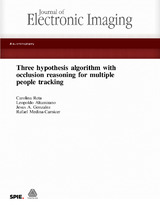Mostrar el registro sencillo del ítem
Three hypothesis algorithm with occlusion reasoning for multiple people tracking
| dc.contributor.author | Reta, Carolina | |
| dc.contributor.author | Altamirano, Jesús | |
| dc.contributor.author | Gónzalez, Jesús A. | |
| dc.contributor.author | Medina-Carnicer, R. | |
| dc.date.accessioned | 2017-12-05T12:43:03Z | |
| dc.date.available | 2017-12-05T12:43:03Z | |
| dc.date.issued | 2015 | |
| dc.identifier.uri | http://hdl.handle.net/10396/15655 | |
| dc.description.abstract | This work proposes a detection-based tracking algorithm able to locate and keep the identity of multiple people, who may be occluded, in uncontrolled stationary environments. Our algorithm builds a tracking graph that models spatio-temporal relationships among attributes of interacting people to predict and resolve partial and total occlusions. When a total occlusion occurs, the algorithm generates various hypotheses about the location of the occluded person considering three cases: (a) the person keeps the same direction and speed, (b) the person follows the direction and speed of the occluder, and (c) the person remains motionless during occlusion. By analyzing the graph, our algorithm can detect trajectories produced by false alarms and estimate the location of missing or occluded people. Our algorithm performs acceptably under complex conditions, such as partial visibility of individuals getting inside or outside the scene, continuous interactions and occlusions among people, wrong or missing information on the detection of persons, as well as variation of the person’s appearance due to illumination changes and background-clutter distracters. Our algorithm was evaluated on test sequences in the field of intelligent surveillance achieving an overall precision of 93%. Results show that our tracking algorithm outperforms even trajectory-based state-of-the-art algorithms. | es_ES |
| dc.format.mimetype | application/pdf | es_ES |
| dc.language.iso | eng | es_ES |
| dc.publisher | IS&T and SPIE | es_ES |
| dc.rights | https://creativecommons.org/licenses/by-nc-nd/4.0/ | es_ES |
| dc.source | Journal of Electronic Imaging 24(1), 013015 (2015) | es_ES |
| dc.subject | People tracking | es_ES |
| dc.subject | Occlusion | es_ES |
| dc.subject | Tracking graph | es_ES |
| dc.subject | Hypothesis management | es_ES |
| dc.subject | Spatio-temporal features | es_ES |
| dc.subject | Video surveillance | es_ES |
| dc.title | Three hypothesis algorithm with occlusion reasoning for multiple people tracking | es_ES |
| dc.type | info:eu-repo/semantics/article | es_ES |
| dc.relation.publisherversion | http://dx.doi.org/10.1117/1.JEI.24.1.013015 | es_ES |
| dc.rights.accessRights | info:eu-repo/semantics/openAccess | es_ES |

